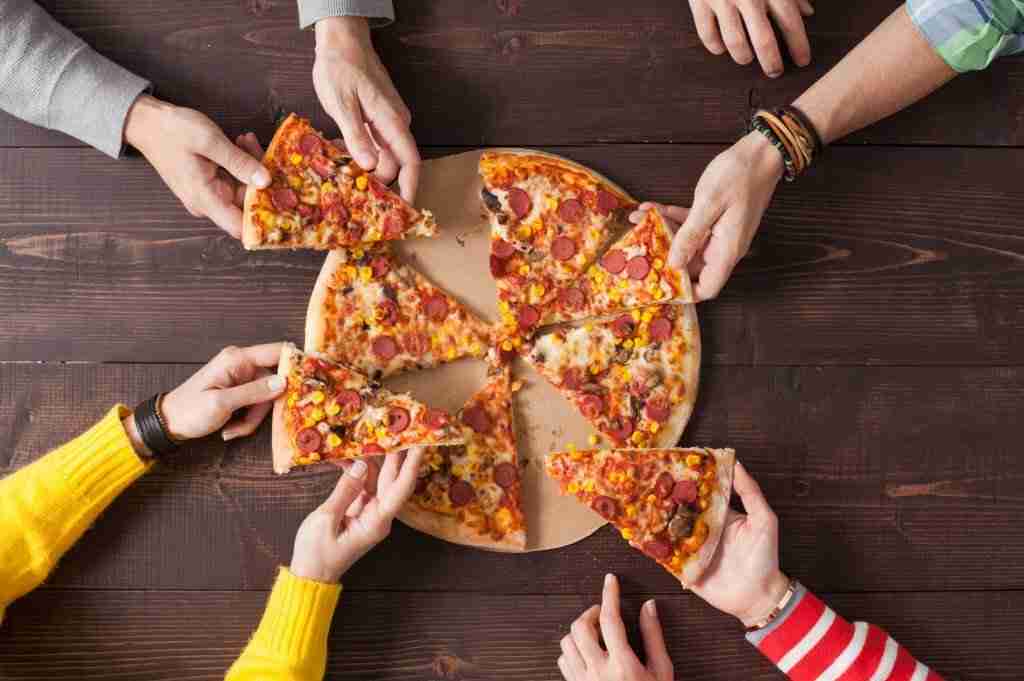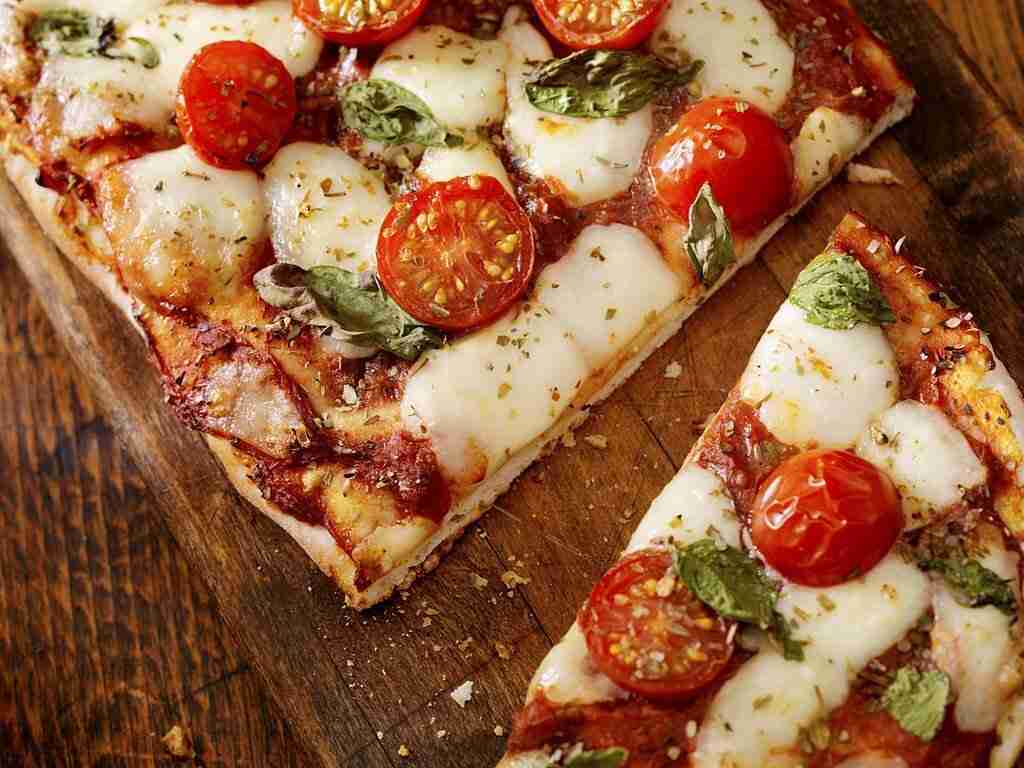
How Many Calories Does A Slice Of Pizza Have?
Pizza is one of the most popular and delicious mealtime staples but it is important to note that it doesn’t rank very high on the list of healthy foods. If you love pizza but still take healthy living seriously, then you might want to keep an eye on the number of pizza calories you munch down per serving.
The FDA recommends about 2000 calories a day for women and 2,500 for men. Pizza has a lot of carbs that can encourage weight gain if consumed in excess amounts. A 14-inch Pepperoni thin crust pizza can contain about 1720 calories and about 82g of that is all fat!
So, how do you enjoy your favorite pizza and still keep those pizza calories in check? You don’t have to toss pizza out of our diet plan just because of its calorie count. Pizza can be a healthy food if you stick to the recommended serving per day and make your dough thin and crusty rather than thick and soft. Whether it’s the Californian or Silican or New York-style pizza, knowing the pizza calories in each slice is a great way to enjoy this gooey, sometimes spicy, and mostly crunchy goodness as you maintain healthy living.
What is Pizza Made Up Of?
Pizza comes in many delicious varieties but traditional pizza consists mostly of the dough, the sauce (mostly tomato sauce), and cheese.
The Dough
This gooey goodness begins with the crust. In the refrigerated section of your local grocery store, you can find pre-made dough or you can just make one at home by yourself with regular all-purpose flour. Calculating the overall pizza calories begins with knowing how many calories are in the dough.
The pizza dough can either be thin and crispy or thick and soft. Assuming you’re making a large family-sized pizza (about 14 inches with 10 slices), keeping the pizza calories in check begins with having a thin and crispy oven-baked crust as suggested earlier.
The pizza dough has four main ingredients: Flour, Yeast, Warm Water, and Olive oil
Flour (2 1/3 cups of all-purpose flour) contains about 1060 calories
Yeast (2 1/4 teaspoons) contains about 29 calories
Warm Water (115 to 120°F) 1 1/3 cups = 180g (0 calories)
Olive Oil (2Tbsp) = 238 calories
Sugar (1Tbsp) = 48 calories
Salt (1Tbsp) = 0 calories
Generally, homemade dough is considered to be healthier than a store-bought one. Here’s a recipe for making dough at home. It is also advisable to stick with regular all-purpose flour which may be bland but you can spice it up with dried basil and garlic and mixed Italian spices.
The Sauce
There are a great variety of pizza sauces to choose from. From the classic traditional tomato-based sauces to chunky marinara to the creamy Alfredo sauce to tapenade to ranch sauce, you can choose what tingles your taste buds and also keeps the pizza calories on a healthy level. You can either serve your sauce right away or store it in the refrigerator if your dough isn’t ready yet.
Sauces differ in their calorie content but traditional pizza sauce, like the homemade one above, can contain about 45 calories per serving.
Popular low-fat sauces include traditional tomato sauce which contains about 25 calories per 1/2 cup), and Marinara sauce which contains about 49 calories per serving cup.
It is much easier to calculate pizza sauce calories when you purchase a canned pizza sauce from your grocery store. Here are some Amazon-recommended pizza sauces
- 14 oz organic pizza sauce
- No sugar added
- An Amazon brand
- One 14 ounce jar of Pizza Sauce
- No artificial colors
- Gluten free
Again, remember that homemade pizzas and sauces are healthier and contain fewer pizza calories than the more processed ones from fast food restaurants and convenience stores.
The Cheese
There are several varieties of pizza cheese and dairy products that are made specifically to be used on pizza. You can choose from the popular, all-time fav Mozzarella or provolone, rich ricotta or parmesan, goat cheese, cheddar, etc.
Mozzarella is considered to have lower calories than other cheese for pizza. Fetta, ricotta, and goat cheese are great options when prioritizing overall pizza calories.
Final Stop, The Toppings
You want to make sure that your toppings are more veggies than meaties, especially if you are trying to lose weight. You can keep those pizza calories at the right level if you make yours at home using fresh vegetables like onions and green peppers, lean meat like chicken or smoked turkey, mushrooms, and spinach. Here’s a pizza topping calorie guide.
Pizza Calories Of Popular Pizzas
Cheese Pizza Calories:
A slice of cheese pizza contains about 178 calories (Carbohydrate: about 22.46g, Fat: about 9.47g, Dietary fiber: about 1.24g, and Protein: about 8.41g). You bring down the calories by reducing the amount of oil, cheese, and sauce you add to your pizza dough. One or two slices of this pizza should be enough for a day.
Pepperoni Pizza Calories:
A slice of pepperoni pizza contains about 327 calories ( Carbohydrate: about 29.42g, Fat 17.77g, Dietary fiber 3.04g, and Protein 14.36g )
Silican Pizza Calories:
A slice of Silican Pizza contains about 300 calories (carbohydrate: about 35.71g, Fat: about 16.14g, Dietary fiber: about 2.86g, and Protein: about 10.75g). You might want to stick with having just a slice of this pizza every other day.
Others include:
Goat Cheese Pizza (1 slice = about 138calories)
Mozzarella Pizza (1 slice = about 154 calories)
Red Pepper Pizza (1 slice = about 165 calories)
Tips To Note If You’re On A Weight Loss Plan But Still Love Pizza
Here are a few tips to help you out if you’re on a weight loss plan but still want to enjoy eating pizza:
More Veggies and Less Meat
A pizza topped with an abundance of meat and cheese can be tasty, but it might not be the healthiest option. A veggie pizza can offer the same satisfying flavor as a meaty pie, but with fewer calories and less fat. Plus, adding extra veggies is a great way to boost your intake of essential vitamins and minerals
Portion Control
This is the key! When you make pizza at home, use a small plate and cut your slices into smaller pieces. This will help you to control how much you eat and prevent overeating. If you’re ordering pizza from a restaurant, consider splitting a pie with a friend or family member.
Choose a Thinner Crust
A lot of calories in pizza come from the crust. If you’re looking to cut back on calories, choose a thinner crust or a whole wheat crust. These options will be lower in calories and fat than a traditional, thick crust pizza.
Limit the Cheese
Cheese is delicious, but it’s also high in fat and calories. If you’re looking to reduce the calorie content of your pizza, go easy on the cheese. You can also try using a lower-fat cheese or a dairy-free cheese alternative.
Make Your own Pizza
This is the best way to control the ingredients in your pizza and make sure that it’s as healthy as possible. When you make pizza at home, you can choose healthy ingredients like whole wheat flour, fresh veggies, and lean meats. You can also control the amount of cheese and sauce you use. Plus, making your own pizza is a fun activity that the whole family can enjoy!
Conclusion
Pizza can be part of a healthy diet if you make smart choices about the ingredients. Choose a thin crust, load up on veggies, and go easy on the cheese and meat. You can also make your own pizza at home using healthy ingredients. Just remember to control portion sizes and limit how often you eat pizza. If you do these things, you can enjoy pizza without compromising your health. Thanks for reading!








